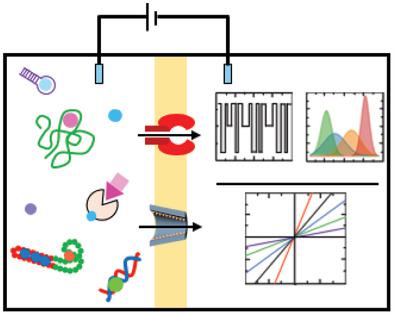当前位置:
X-MOL 学术
›
Small Methods
›
论文详情
Our official English website, www.x-mol.net, welcomes your feedback! (Note: you will need to create a separate account there.)
Nanopore Detection of Metal Ions: Current Status and Future Directions
Small Methods ( IF 12.4 ) Pub Date : 2020-08-09 , DOI: 10.1002/smtd.202000266 Golbarg Mohammadi Roozbahani 1 , Xiaohan Chen 1 , Youwen Zhang 1 , Liang Wang 2, 3 , Xiyun Guan 1
Small Methods ( IF 12.4 ) Pub Date : 2020-08-09 , DOI: 10.1002/smtd.202000266 Golbarg Mohammadi Roozbahani 1 , Xiaohan Chen 1 , Youwen Zhang 1 , Liang Wang 2, 3 , Xiyun Guan 1
Affiliation

|
In this review, recent research efforts that aimed at developing nanopore sensors for detection of metal ions, which play a crucial role in environmental safety and human health, are highlighted. Protein pores use three stochastic sensing‐based strategies for metal ion detection. The first strategy is to construct engineered nanopores with metal ion binding sites, so that the interaction between the target analytes and the nanopore can slow the movement of metal ions in the nanochannel. Second, large molecules such as nucleic acids and especially peptides can be utilized as external selective molecular probes to detect metal ions based on the conformational change of the ligand molecules induced by the metal ion–ligand chelation/coordination interaction. Third, enzymatic reactions can also be used as an alternative to the molecule probe strategy in the situation that a sensitive and selective probe molecule for the target analyte is difficult to obtain. On the other hand, by taking advantage of steady‐state analysis, synthetic nanopores mainly use two strategies (modification and modification‐free) to detect metals. Given the advantages of high sensitivity and selectivity, and label‐free detection, nanopore‐based metal ion sensors should find useful application in many fields, including environmental monitoring, medical diagnosis, and so on.
中文翻译:

金属离子的纳米孔检测:现状和未来方向
在这篇综述中,重点介绍了最近旨在开发用于检测金属离子的纳米孔传感器的研究工作,金属离子在环境安全和人类健康中起着至关重要的作用。蛋白质孔使用三种基于随机传感的策略进行金属离子检测。第一种策略是构建具有金属离子结合位点的工程纳米孔,以便目标分析物与纳米孔之间的相互作用可以减缓金属离子在纳米通道中的运动。其次,基于由金属离子-配体螯合/配位相互作用引起的配体分子的构象变化,大分子如核酸,尤其是肽可用作外部选择性分子探针来检测金属离子。第三,在难以获得针对目标分析物的灵敏且选择性的探针分子的情况下,酶促反应也可用作分子探针策略的替代方案。另一方面,利用稳态分析,合成纳米孔主要使用两种策略(修饰和无修饰)来检测金属。鉴于高灵敏度和选择性以及无标记检测的优势,基于纳米孔的金属离子传感器应该在许多领域得到有用的应用,包括环境监测、医学诊断等。合成纳米孔主要使用两种策略(修饰和无修饰)来检测金属。鉴于高灵敏度和选择性以及无标记检测的优势,基于纳米孔的金属离子传感器应该在许多领域得到有用的应用,包括环境监测、医学诊断等。合成纳米孔主要使用两种策略(修饰和无修饰)来检测金属。鉴于高灵敏度和选择性以及无标记检测的优势,基于纳米孔的金属离子传感器应该在许多领域得到有用的应用,包括环境监测、医学诊断等。
更新日期:2020-10-07
中文翻译:

金属离子的纳米孔检测:现状和未来方向
在这篇综述中,重点介绍了最近旨在开发用于检测金属离子的纳米孔传感器的研究工作,金属离子在环境安全和人类健康中起着至关重要的作用。蛋白质孔使用三种基于随机传感的策略进行金属离子检测。第一种策略是构建具有金属离子结合位点的工程纳米孔,以便目标分析物与纳米孔之间的相互作用可以减缓金属离子在纳米通道中的运动。其次,基于由金属离子-配体螯合/配位相互作用引起的配体分子的构象变化,大分子如核酸,尤其是肽可用作外部选择性分子探针来检测金属离子。第三,在难以获得针对目标分析物的灵敏且选择性的探针分子的情况下,酶促反应也可用作分子探针策略的替代方案。另一方面,利用稳态分析,合成纳米孔主要使用两种策略(修饰和无修饰)来检测金属。鉴于高灵敏度和选择性以及无标记检测的优势,基于纳米孔的金属离子传感器应该在许多领域得到有用的应用,包括环境监测、医学诊断等。合成纳米孔主要使用两种策略(修饰和无修饰)来检测金属。鉴于高灵敏度和选择性以及无标记检测的优势,基于纳米孔的金属离子传感器应该在许多领域得到有用的应用,包括环境监测、医学诊断等。合成纳米孔主要使用两种策略(修饰和无修饰)来检测金属。鉴于高灵敏度和选择性以及无标记检测的优势,基于纳米孔的金属离子传感器应该在许多领域得到有用的应用,包括环境监测、医学诊断等。



























 京公网安备 11010802027423号
京公网安备 11010802027423号